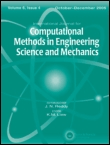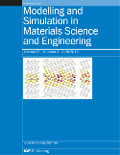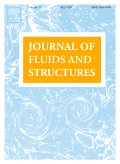
Computational Particle Mechanics
Scope & Guideline
Pioneering Research in Fluid Dynamics and Structural Engineering
Introduction
Aims and Scopes
- Discrete Element Method (DEM) Applications:
The journal extensively covers research utilizing the Discrete Element Method to simulate the behavior of granular materials, including their mechanical properties, flow dynamics, and interactions under various loading conditions. - Fluid-Structure Interaction:
Research in this area explores the interactions between fluid flows and solid structures, employing methods such as Smoothed Particle Hydrodynamics (SPH) and other meshless techniques to address complex fluid dynamics and structural responses. - Multiscale Modeling:
The journal promotes studies that integrate multiple scales of analysis, from microscopic particle interactions to macroscopic material behavior, using combined approaches like DEM-FEM and peridynamics. - Numerical Methods and Algorithms:
Focus on the development of new numerical methods and algorithms for particle-based simulations, including enhancements in computational efficiency, accuracy, and stability across various applications. - Experimental Validation of Computational Models:
The journal encourages contributions that validate computational models through experimental studies, ensuring that theoretical predictions align with real-world observations. - Innovative Material Characterization:
Research on advanced techniques for characterizing the mechanical and physical properties of new materials, including composites and nanomaterials, is a key focus area.
Trending and Emerging
- Hybrid Computational Approaches:
There is a rising trend in the use of hybrid methods that combine different computational techniques, such as DEM, FEM, and SPH, to tackle complex problems in material mechanics and fluid dynamics. - Advanced Machine Learning Applications:
An increasing number of studies are incorporating machine learning techniques for parameter optimization, predictive modeling, and data analysis, showcasing the integration of AI in computational particle mechanics. - Sustainability and Eco-Friendly Materials:
Research addressing the mechanical properties and behaviors of sustainable materials, including bio-based composites and recycled materials, is gaining momentum, reflecting a broader societal push towards sustainability. - Nanoparticle and Microstructural Studies:
Emerging interest in the behavior of nanoparticles and the influence of microstructural features on material properties indicates a growing focus on materials at the nanoscale, with implications for various engineering applications. - Dynamic and Impact Loading Scenarios:
There is an increased emphasis on understanding the behavior of materials under dynamic and impact loading conditions, particularly in contexts such as construction, mining, and aerospace engineering.
Declining or Waning
- Traditional Continuum Mechanics Approaches:
There is a noticeable decline in papers focusing solely on classical continuum mechanics methods, with a shift towards more particle-based and hybrid approaches that provide greater flexibility in modeling complex systems. - Geotechnical Engineering Studies:
Although still relevant, the frequency of papers specifically addressing traditional geotechnical engineering issues, such as soil mechanics using conventional methods, seems to be waning in favor of more innovative, computationally-intensive approaches. - Single-Phase Fluid Dynamics:
Research exclusively centered on single-phase fluid dynamics appears to be declining, as there is a growing interest in multiphase and complex fluid interactions that involve particulate matter.
Similar Journals

Izvestiya of Saratov University Mathematics Mechanics Informatics
Connecting Ideas: Where Mathematics Meets Mechanics and InformaticsIzvestiya of Saratov University Mathematics Mechanics Informatics is a prominent open access journal published by Saratov State University, focusing on the interdisciplinary fields of mathematics, mechanics, and computer science. Established as an accessible platform for researchers since 2007, this journal fosters the dissemination of innovative research and advancements in computational mechanics, general mathematics, and mechanical engineering among others. Although currently categorized within the Q4 quartile rankings in various domains, including Computational Mechanics and Mechanics of Materials, it serves as a crucial resource for professionals and scholars aiming to explore emerging trends and methodologies. Operating out of Saratov, Russian Federation, this journal not only contributes to local academic discourse but also holds international relevance, welcoming submissions that push the boundaries of traditional research. Researchers, professionals, and students alike are encouraged to engage with the wealth of knowledge presented within its pages, reinforcing the journal’s role as a vital component in the ongoing development of these scientific fields.

ACTA MECHANICA SINICA
Unveiling Breakthroughs in Mechanical Engineering ResearchACTA MECHANICA SINICA is a prestigious journal published by SPRINGER HEIDELBERG that has been a cornerstone in the field of mechanical engineering and computational mechanics since its inception in 1985. Based in Germany, this leading publication is internationally recognized for its high impact, holding a Q1 ranking in both Computational Mechanics and Mechanical Engineering as of 2023. It is positioned prominently within the academic community, evidenced by its respectable Scopus rankings—#21 in Computational Mechanics and #159 in Mechanical Engineering, both within the 76th percentile. Researchers and professionals alike turn to ACTA MECHANICA SINICA for cutting-edge research, innovative methodologies, and insights that drive advancements in the discipline. Although the journal is not open access, its rigorous peer-review process ensures the publication of high-quality, impactful research that is essential for scholars and practitioners aiming to stay at the forefront of mechanical engineering advancements.

Proceedings of the Institution of Civil Engineers-Engineering and Computational Mechanics
Exploring the Intersection of Engineering and Computational MechanicsProceedings of the Institution of Civil Engineers - Engineering and Computational Mechanics is a prestigious journal published by Emerald Group Publishing Ltd, dedicated to advancing the fields of civil and structural engineering, as well as mechanics of materials. With an ISSN of 1755-0777 and E-ISSN 1755-0785, this journal serves as a critical platform for disseminating innovative research and practical insights from 2009 through 2024. As part of its commitment to academic rigor, it is categorized in the Q4 quartile for both civil and structural engineering and mechanics of materials, reflecting a unique position in the scholarly community. The journal is essential for professionals, researchers, and students aiming to stay informed on current trends, methodologies, and applications in engineering and computational mechanics. By engaging with this publication, readers gain access to crucial findings that contribute to the advancement of infrastructure and materials science, vital for developing resilient and sustainable engineering solutions.

Journal of the Serbian Society for Computational Mechanics
Advancing Computational FrontiersJournal of the Serbian Society for Computational Mechanics, published by the Serbian Society for Computational Mechanics, is a vital platform for advancing research and knowledge in the field of computational mechanics. Established in 2012, this journal serves the academic community by providing a forum for innovative studies, methodologies, and applications within computational mechanics, presenting valuable insights for researchers, professionals, and students alike. With an ISSN of 1820-6530 and a ranking of Q4 in Computational Mechanics, it carries an essential influence in the engineering realm, despite its current rank of 71 out of 89. The journal's commitment to scholarly excellence aims to foster collaboration and encourage interdisciplinary research, making it an important resource for those invested in the evolving landscape of computational methodologies. Although the journal currently does not offer Open Access options, it remains dedicated to disseminating knowledge that will resonate within the local and global scientific community.

International Journal for Computational Methods in Engineering Science & Mechanics
Pioneering Innovative Solutions in Mechanics and MathematicsThe International Journal for Computational Methods in Engineering Science & Mechanics, published by Taylor & Francis Inc., serves as a vital resource for researchers and professionals involved in the fields of computational mathematics and mechanics. With an ISSN of 1550-2287 and an E-ISSN of 1550-2295, this journal has been a cornerstone of scholarly communication since its inception in 2005 and will continue to publish cutting-edge research through 2024. Its impressive Scopus rankings highlight its impact within the field, placing it in the top quartiles for both Computational Mechanics (Q2) and Computational Mathematics (Q3), showcasing its significance for academics striving to push the boundaries of these disciplines. The journal features high-quality peer-reviewed articles that emphasize innovative computational methods, numerical analyses, and their applications in engineering science. While currently not available as an open-access option, this publication remains an essential reference for those seeking to stay at the forefront of computational methodologies in engineering practice.

MODELLING AND SIMULATION IN MATERIALS SCIENCE AND ENGINEERING
Shaping the Future of Materials Through ResearchMODELLING AND SIMULATION IN MATERIALS SCIENCE AND ENGINEERING, published by IOP Publishing Ltd, serves as a vital resource for researchers, professionals, and students engaged in the multifaceted fields of materials science, condensed matter physics, and computational mechanics. Since its inception in 1992, this journal has been committed to advancing knowledge through high-quality research articles, reviews, and simulations that explore complex interactions within materials. With an impressive Scopus rank in multiple categories, including Q2 in Materials Science and Mechanics of Materials, it reflects its significant influence and relevance in the academic community. Though not an open-access journal, it provides critical insights and developments in modeling techniques and simulations aimed at improving material performance and understanding thermodynamic processes, making it an essential read for those at the forefront of materials innovation. As it continues to expand its scope and reach into 2024 and beyond, MODELLING AND SIMULATION IN MATERIALS SCIENCE AND ENGINEERING remains a key platform for disseminating groundbreaking research that shapes the future of the discipline.

International Journal of Computational Methods
Empowering researchers to shape the future of computational methods.The International Journal of Computational Methods is a premier academic journal dedicated to advancing the field of computational mathematics and its applications in various domains of computer science. Published by WORLD SCIENTIFIC PUBL CO PTE LTD, this journal serves as a critical platform for researchers and practitioners to disseminate innovative computational techniques and methodologies that address complex problems in science and engineering. With a significant focus on fostering interdisciplinary collaboration, the journal is essential for those looking to explore cutting-edge topics in computational methods. Established in 2006 and spanning until 2024, it holds respectable rankings in Q3 for Computational Mathematics and Q2 for Miscellaneous Computer Science as of 2023, reflecting its growing impact in the academic community. Although the journal is not currently open access, it offers various subscription options to enable access to its high-quality research articles. By bridging theoretical advancements and practical implementations, the International Journal of Computational Methods plays a vital role in shaping future innovations within both academic and industrial settings.

Journal of Theoretical and Applied Mechanics
Championing Open Access to Mechanical InsightsJournal of Theoretical and Applied Mechanics, published by the Polish Society of Theoretical and Applied Mechanics, stands as a leading platform for disseminating cutting-edge research in the realms of theoretical and applied mechanics. With its ISSN 1429-2955 and E-ISSN 1429-2955, this Open Access journal has been fostering academic dialogue since 2006, making knowledge readily accessible to researchers and practitioners alike. Based in Warsaw, Poland, the journal encompasses a wide breadth of topics within mechanics, appealing to a diverse readership including researchers, professionals, and students. The journal's current Scopus ranking places it within the 30th percentile of the field, emphasizing its relevance and contribution to the discipline. As it converges from 2007 to 2024, the Journal of Theoretical and Applied Mechanics is pivotal for those seeking to advance understanding and innovation in mechanical engineering and mathematics, making it an essential resource for anyone involved in these critical areas of study.

JOURNAL OF FLUIDS AND STRUCTURES
Transforming Understanding of Fluid-Structure DynamicsJournal of Fluids and Structures, published by Academic Press Ltd - Elsevier Science Ltd, is a premier international journal dedicated to the interdisciplinary field of fluid-structure interactions. With an impressive impact factor and ranking in the Q1 category for Mechanical Engineering and a Scopus ranking of #119 out of 672, this journal serves as a vital resource for researchers, professionals, and students alike. Since its inception in 1987, it has consistently delivered cutting-edge research and comprehensive reviews that contribute significantly to the understanding of fluid dynamics and structural mechanics. The journal emphasizes innovative methodologies and advances in the analysis of complex interactions between fluids and structures, making it essential for those at the forefront of engineering and applied physics. Additionally, with converged years from 1987 to 2024, the journal has maintained a commitment to fostering academic discourse and presenting groundbreaking research that shapes the future of the field.

Moscow University Mechanics Bulletin
Connecting Innovators in Mechanical ResearchMoscow University Mechanics Bulletin, published by PLEIADES PUBLISHING INC, is a dedicated journal that has been influencing the fields of mechanical engineering and mechanics since its inception. With an ISSN of 0027-1330 and E-ISSN of 1934-8452, this journal serves as a crucial platform for advancing knowledge in mathematics, mechanical engineering, and mechanics of materials. Though currently indexed in the Q4 category across these disciplines, it offers a unique space for researchers and professionals to engage with emerging theories, experimental results, and practical applications. With a converged publication history spanning from 1973 to 1987, and continuing from 2007 to 2024, the journal remains relevant in today’s academic landscape. Though it operates under traditional access models, the journal's global reach aims to connect diverse voices in engineering research. Aspiring researchers and seasoned professionals alike will find valuable insights and a robust discourse that contribute to their respective fields.